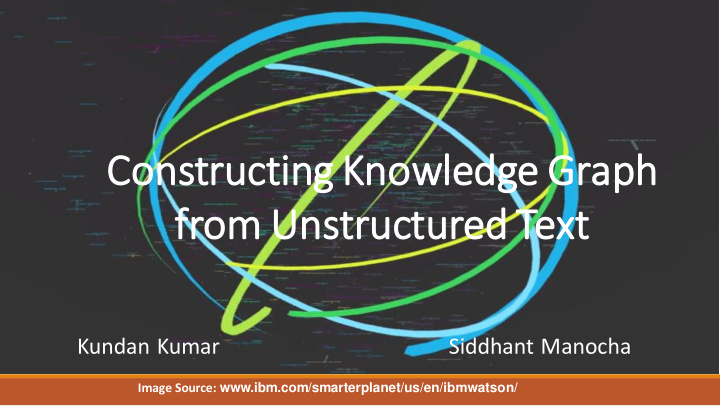



Cons nstruc ucting g Knowledg dge e Gr Graph ph from Un Unstruc uctur ured d Tex ext Kundan Kumar Siddhant Manocha Image Source: www.ibm.com/smarterplanet/us/en/ibmwatson/
MOTIVATION Image Source: KDD 2014 Tutorial on Constructing and Mining Web-scale Knowledge Graphs, New York
MOTIVATION Image Source: KDD 2014 Tutorial on Constructing and Mining Web-scale Knowledge Graphs, New York
MOTIVATION Image Source: KDD 2014 Tutorial on Constructing and Mining Web-scale Knowledge Graphs, New York
PROBLEM STATEMENT
KNOWLEDGE GRAPH http://courses.cs.washington.edu/courses/cse517/13wi/slides/cse517wi13-RelationExtraction.pdf
KNOWLEDGE GRAPH http://courses.cs.washington.edu/courses/cse517/13wi/slides/cse517wi13-RelationExtraction.pdf
QUESTION ANSWERING
EXISTING KNOWLEDGE BASES Image Source: KDD 2014 Tutorial on Constructing and Mining Web-scale Knowledge Graphs, New York
EXISTING KNOWLEDGE BASES Supervised Models: ◦ Learn classifiers from +/- examples, typical features: context words + POS, dependency path between entities, named entity tags ◦ Require large number of tagged training examples ◦ Cannot be generalized Semi-Supervised Models: ◦ Bootstrap Algorithms: Use seed examples to learn initial set of relations ◦ Generate +ve/-ve examples to learn a classifier ◦ Learn more relations using this classifier Distant Supervision: ◦ Existing knowledge base + unlabeled text generate examples ◦ Learn models using this set of relations
OUR APPROACH Bootstrapping Relations using Distributed Word Vector Embedding 1) Word that occur in similar context lie close together in the word embedding space. 2) Word Vectors is semantically consistent and capture many linguistic properties (like 'capital city', 'native language', 'plural relations') 3) Obtain word vectors from unstructured text ( using Google word2vec, Glove, etc ) 4) Exploit the properties of the manifold to obtain binary relations between entities
Image Source: KDD 2014 Tutorial on Constructing and Mining Web-scale Knowledge Graphs, New York ALGORITHM
SIMILARITY METRIC Image Source:A survey on relation extraction, Nguyen Bach, Carnegie Mellon University
KERNEL BASED APPROACHES
DEPENDENCY KERNELS 1.Actual Sentences 2. Dependency Graph Kernel: K(x,y)=3×1×1×1×2×1×3 = 18 3.Kernel Computation Image Source:A Shortest Path Dependency Kernel for Relation Extraction,Mooney,et al
PRELIMINARY RESULTS Word Vector Embedding: Wikipedia Corpus
PRELIMINARY RESULTS (wikipedia corpus) Negative Relations learnt Positive relations learnt Seed Examples for capital relationship
PRELIMINARY RESULTS (google news corpus) Negative Relations Learned Seed Examples Positive Relations Learned
References 1)Tomas Mikolov, Wen-tau Yih, and Geoffrey Zweig. Linguistic Regularities in Continuous Space Word Representations. In Proceedings of NAACL HLT, 2013. 2) Tomas Mikolov, Ilya Sutskever, Kai Chen, Greg Corrado, and Jeffrey Dean. Distributed Representations of Words and Phrases and their Compositionality. In Proceedings of NIPS, 2013. 3) Eugene Agichtein Luis Gravano. Snowball: Extracting Relations from Large Plain-T ext Collections. In Proceedings of the fifth ACM conference on Digital libraries, June 2000
Questions!
CBOW MODEL • input vector represented as 1-of-V encoding • Linear sum of input vectors are projected onto the projection layer • Hierarchical Softmax layer is used to ensure that the weights in the output layer are between 0<=p<=1 • Weights learnt using back- propagation • The projection matrix from the projection layer to the hidden layer give the word vector embeddings Image Source: Linguistic Regularities in Continuous Space Word Representations,Mikolov,et.al 2013
WORD VECTOR MODEL
WORD VECTOR MODEL
KERNEL BASED APPROACHES Image Source:Kernel Methods for Relation Extraction,Zelenko,et al
Recommend
More recommend